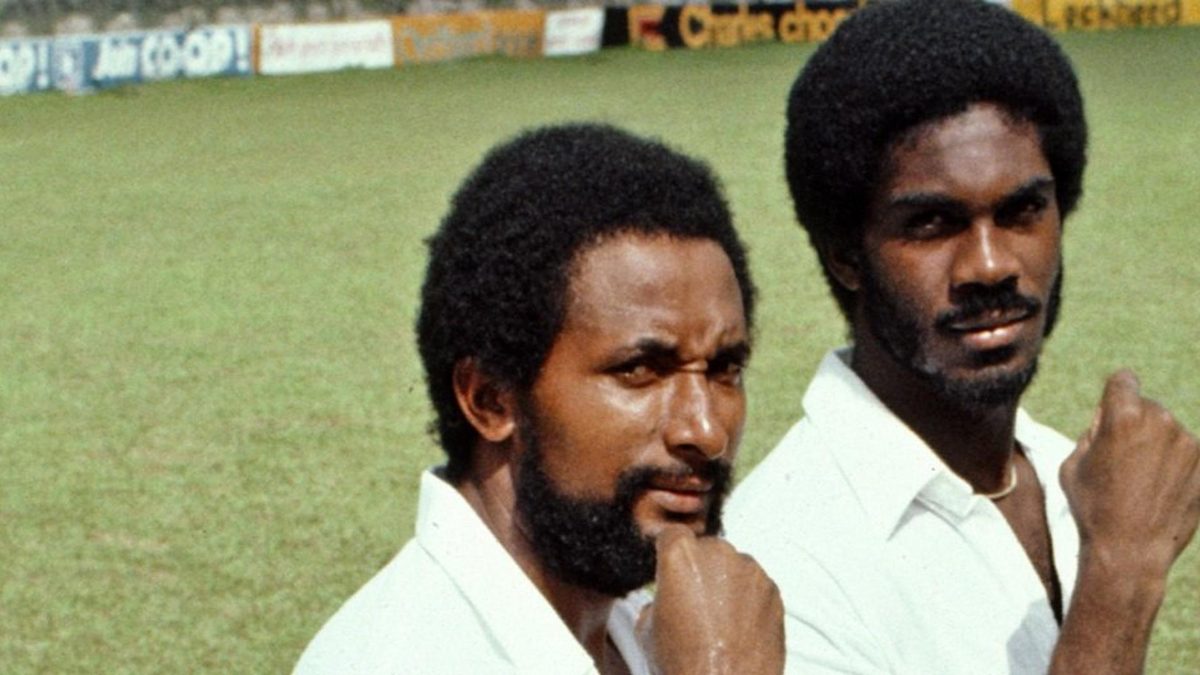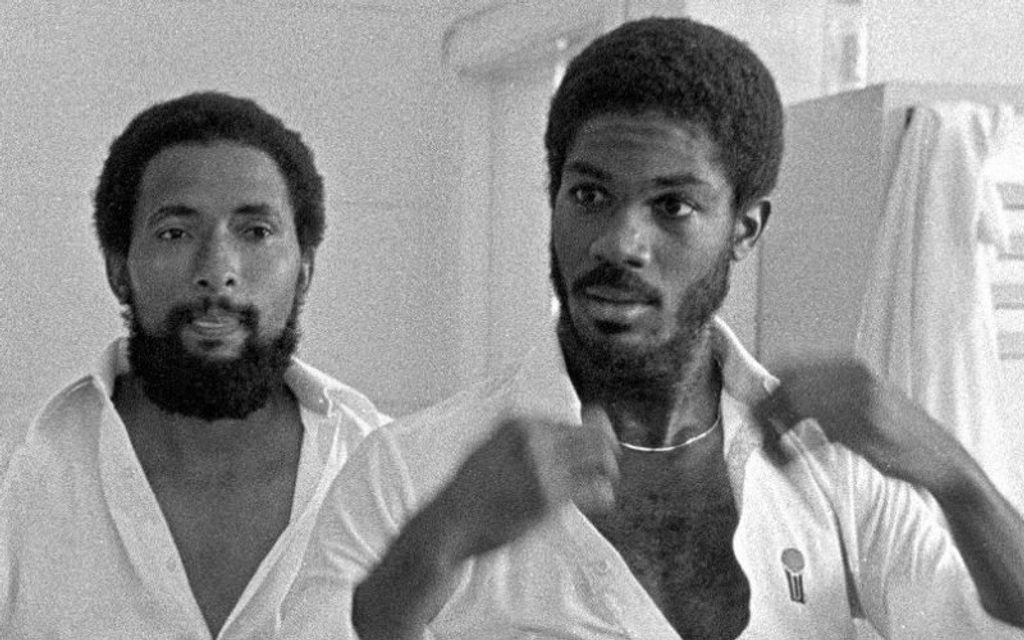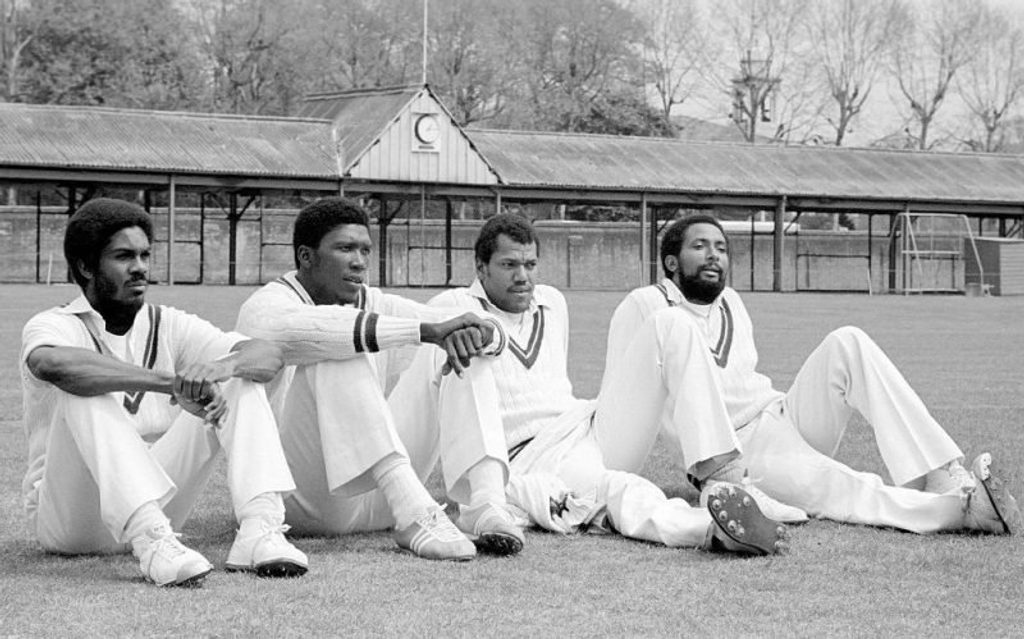
Andy Roberts and Michael Holding, the giant fast-bowling pillars of the unconquerable West Indies side of the Seventies and Eighties talk us through their formidable partnership.
First published in 2014
When you talk about fast bowling, your thoughts turn to the great West Indian arsenal of the Seventies and Eighties. Within that, two men, Michael Holding and Andy Roberts, provided the most varied and deadly combination. After meeting during 12th man duties in regional first-class cricket, they spent their future taking turns terrifying batsmen. Ed Kemp spoke to them about their partnership.
Tell us a little bit about the relationship you two have on and off the field…
Michael Holding: We were friends before we started playing for the West Indies. The first time we met was when he was 12th man for the Combined Islands, as his team was called then [later the Leeward Islands of which Roberts’ Antigua was a part would split from the Windward Islands to create two separate teams], and I was 12th man for Jamaica. We were sat on the bench at Sabina Park, watching the game and chatting. Then the next day we both played for our respective islands.
Andy Roberts: We have remained true and loyal friends even to this day. We speak on a regular basis and more often than not, the subject is cricket. We shared some great moments on and off the field. Towards the end or from the middle of our careers we were roommates and a lot of planning went on in that room because we didn’t have the luxury of video replays. What we had was memory.
MH: Yes, we roomed together when I played for the West Indies and in World Series Cricket. And he was best man at my first wedding and I was best man at his. I’m not a great believer in astrology but we’re both Aquarians as well! Jamaica and Antigua have a lot of similarities. Our accents are not that far apart and some of the slang words that we use are quite similar.
AR: We were tuned into cricket because that’s what we chose as a profession and we had to try to be the best that we could be. We helped each other along over the years. You know, if I see Michael is doing something that looks odd to me, I will go up and draw it to his attention. He will do the same for me. So, we formed a very good relationship or understanding and up to this day, it still remains the same.
 In 30 Tests played together, Roberts and Holding took 233 wickets between them at 25.65
In 30 Tests played together, Roberts and Holding took 233 wickets between them at 25.65
Are we right in thinking that you, Andy, had a hand in Michael’s first Test wicket?
AR: Yes. It was at Perth. Michael bowled in the first Test match in Brisbane without any luck whatsoever. He had a few catches dropped and he felt he was going to get wickets. I was fielding at mid-off and I told him to try something different.
MH: I was bowling fast but I still wasn’t getting any wickets and I was bowling at a lot of stages of the Australian innings so I was getting a little bit tired. I was bowling to Max Walker and Andy came to me and said, “Bowl a short ball on Max Walker’s off stump”.
AR: He was reluctant to do it! I’ve never been reluctant to bowl short at anybody because I know I’m going to get it. So, why not be the first?
Happy birthday to legendary former @windiescricket, @hantscricket and @leicsccc fast bowler, Andy Roberts. Here’s what @WisdenAlmanack said when he was a Cricketer of the Year in 1975 – https://t.co/4nlEGGOAxz #cricketeroftheyear
— Wisden Almanack (@WisdenAlmanack) January 29, 2020
MH: I told him that I was feeling tired and I couldn’t really bang anything in at that stage. Andy said, “Don’t worry, just put everything into one delivery and just try that”. I did and he fended it off into the gully or third-slip region and I think Viv Richards was the person who took the catch. And that was my first wicket. He has helped me with many other wickets, too.
Did you regularly advise each other during your spells?
AR: Oh yes. We used to talk. We were both learning the game at the time so we didn’t have any experiences to share with each other but as the years went by we shared a lot of experiences, too.
MH: Andy made the West Indies team before me. He got into the West Indies team in ‘74, I think. He went to India with them. I got into the team in 1975/76. My first tour was down to Australia.
 The deadly four: (left-right) Michael Holding, Joel Garner, Colin Croft and Andy Roberts at Lord’s, circa May 1980
The deadly four: (left-right) Michael Holding, Joel Garner, Colin Croft and Andy Roberts at Lord’s, circa May 1980
AR: Well, we were both young guys and it was just ‘look and learn’. Try and learn as much as possible without saying too much. Michael was like that in the beginning but after a while, just like myself, he started to talk about things he saw which he didn’t like. But he looked and he learned. I had the benefits of making my first tour with Keith Boyce, Vanburn Holder and players like that. So I learned from them and Michael came in a year after.
MH: I was in India once and Andy wasn’t playing, he had the flu and was watching the game in the dressing room. In one drinks break, he sent out a message with the 12th man – I think it might have been Derick Parry, I’m not absolutely sure – telling me to go round the wicket and bowl at Syed Kirmani’s leg-stump. Of course, I thought to myself, ‘Why would I be trying to attack a batsman’s leg-stump?’ But Andy had obviously seen that Kirmani was shuffling away towards his off -stump and he perhaps thought the best way of hitting that leg-stump was not to bowl over but to go around. And he perhaps would shuffle in the same direction. And as said, so done. Kirmani lost his leg-stump.
As far as you guys as a bowling partnership was concerned, what was going right? How did you complement each other?
MH: We were different. Initially, Andy was the quickest of the two. I was just learning my trade. So, early in my career I didn’t know a lot to work out many opposition batsmen and that sort of thing. But by the time I’d got to learn more about fast bowling and learned more about the game, Andy and myself would work out the opposition and we would target different batsmen in different ways. Because of his skills and my skills. I developed a great deal of pace; I was quicker than Andy at a lot of stages. So, he would use his guile, I would use more pace than anything else. But in the evenings, we would always discuss opposition batsmen and who would be better at bowling to which batsmen.
AR: We complemented each other by looking at what we thought were the weak points of the batsmen and pinpointing them to one another. Michael had pace and I was using variety, I’d bowl at different paces. Plus, Michael bowled at different lengths to me so you could not play both of us the same. You had to play Michael more in-between. You couldn’t go forward, you couldn’t go back because it was not short enough to go back. Whereas with me, you would have to play me more off your front foot because I would pitch it up a little more than Mikey did.
Did you ever face each other in the nets?
AR: Yes, we bowled at each other in the nets but we pitched the ball up! The only one who didn’t was Colin Croft. There’s a story that the Adelaide nets are renowned as the fastest nets in Australia. And Colin Croft would bowl short at everybody. Everybody. Then, one day, Clive Lloyd said, “Crofty, pad up!” And all the batsmen ran to the box where the new balls were kept.
It only seems right that we talk about the 1976 series in England. Where were you both at, in terms of your careers, leading up to that summer?
MH: I was just learning my trade. From the very beginning, you felt as if, ‘Okay. That’s the senior group and we are the youngsters coming on board now to try and learn’. So you were almost taking a back seat. Not literally, but mentally and psychologically taking a back seat and looking up to those guys.
AR: My action changed over the years; from when I made my debut in England in 1974 up to when I played in 1976. My action changed a hell of a lot. It started from an article I read by Fred Truman. I went into the nets and started to get my arms into a much higher position – especially my front arm, not the back arm – and I found that helped me to swing the ball a lot more.
MH: I think Andy bowled brilliantly in Australia in 1975. If we had the independent panel of umpires that we have now in Test cricket, I think Andy would’ve got a lot more wickets on that Australia tour. He was dynamic. He got those Chappells out on so many occasions but of course, they weren’t given out. The same Perth Test, I think he took something like seven wickets in one innings. Andy was still extremely quick and, of course, had so much expertise. He would’ve got a lot more wickets if we’d had some neutral umpires.
https://www.youtube.com/watch?v=lLZLleIzApM
AR: Playing in England helped me develop an outswinger. In my early years I used to bowl fast and straight, but as I changed my action, I developed an outswinger. And that is one of the things I would like to instill in young fast bowlers; to know your action and to know the benefits of it because your action can present different benefits. Up to when I finished cricket, my action was still changing because I found there were different things I could do which were beneficial for me.
And the series itself, collectively, must have been a great time. What were the individual highlights?
AR: Michael’s 14 wickets at The Oval. I’ve never seen anyone bowl like that on a flat pitch. My most satisfying performance, at a Test match, was the three wickets in the second innings at Headingley. That was because England only had to make 260 on a pitch that produced 429 runs on the first day. Not the whole first innings, but the first day. England followed that by scoring, I think, over 400 and we were struggling in our second innings. I thought that we needed quick wickets and the only thing that could have brought us back into the game was quick wickets. And I got three wickets in the space of four or five overs. To this day, I will go down saying, go to my grave saying, if David Constant had given Peter Willey out leg before, England would not have survived that afternoon. I can tell you that.
“‘Here are my weapons’ he seems to say. He looks so relaxed, so in control.”@benjonescricket on the iconic Holding photo from 1976, an image that perfectly captures the man’s charm. https://t.co/ItwsIomVKQ
— Wisden (@WisdenCricket) April 29, 2020
What were the most special moments you shared?
AR: I’d say 1979/80 in Australia. That sticks out in my mind because that was the first time the West Indies had ever beaten Australia, in Australia. That stood out. When Clive Lloyd hit the winning runs in Perth to win the series – because we were already one up – when we won the last Test match and beat them 2-0. That stood out in my mind.
MH: For me it’s not that particular moment that Clive Lloyd hit the four because yes, you remember that, but the fact that it was the first time that the West Indies had beaten Australia, in Australia, will live with me forever. That is the highlight of my career. Not personally taking any amount of wickets but the fact that I was a part of that team.
Did you feel that you were the best of the Windies quicks?
AR: Well, yeah, at one time or another but then it revolves. As Mikey got into his game, he was overtaking me and I had to work harder to try and keep up the level I thought I should be at. Then here comes Joel Garner … I could not compete with Joel Garner because of his great height. He would present a lot more problems than I could. And Colin Croft – he was a freak! I had to find something else that I could do.
MH: As Andy lost his pace, he recognised that he had to develop other things. I remember him getting one of the Indians with a slower ball in Jamaica once. And in those days, in the early Eighties, you didn’t find a lot of slow balls being bowled in Test match cricket. Andy even developed two types of bouncers.
AR: Once a batsman gets accustomed to one pace then it’s very difficult for you to upset them. But if you vary the pace – and it’s always good for a batsman to feel comfortable when he plays a shot – the next bouncer would be one to make him uncomfortable. So it’s always a lot faster than the first one. And, you know, it is so easy. So many people have said to me, “How do you do it?” But it’s so easy.
Did the way Andy’s career ended bring the partnership – on the field at least – to a premature conclusion?
AR: I thought I could have played on for another two years and it was sad. There are many reasons that come to me as to why I was sent home from that tour to India. And it had absolutely nothing to do with cricket or my performances because the season before, I was the leading wicket-taker in the Caribbean. And I hardly played any matches in India, except for the last two and I think I ended up getting five or six wickets in the two Test matches and we won the series. It was to do with something other than cricket.
MH: The way Andy’s career ended was unfortunate, I think. He missed out on much in India because of illness and he struggled to get back in. And I’m not too sure that he should have [missed out]. But such is life. I think when you have two people who are sharing something, whether it be opening the batting or opening the bowling, and you have a good relationship with each other, I think it helps a great deal. We certainly had that. Not had, have.








